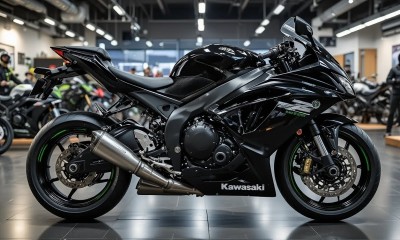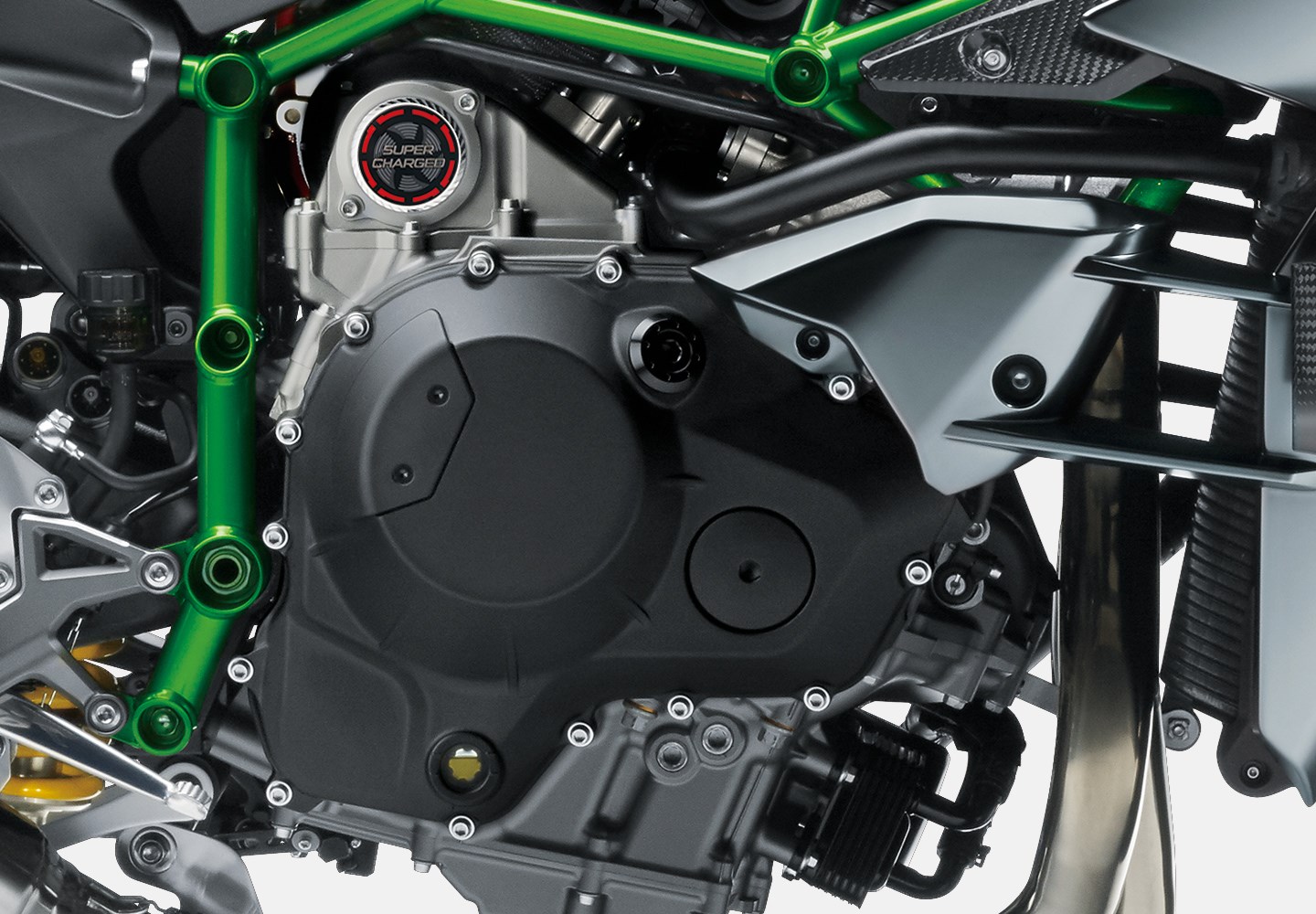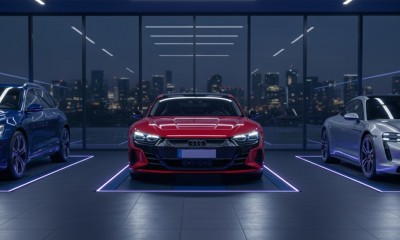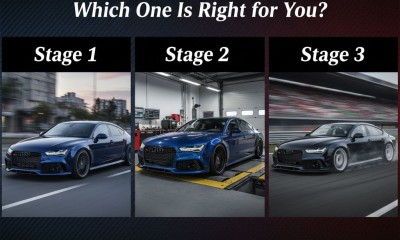Kawasaki Ninja H2R: Unlocking 326 HP with Pro ECU Tuning (0-60 & Specs)

The Kawasaki Ninja H2R is not merely a high-performance motorcycle; it is a definitive statement of engineering supremacy. Conceived as a halo product, it represents the collective technological might of Kawasaki Heavy Industries, Ltd. (KHI), a conglomerate with deep expertise in aerospace, gas turbines, and heavy machinery. The H2R was born from an unprecedented collaboration between these divisions, with a singular goal: to push the boundaries of performance without the constraints of street homologation. This makes it the world's only limited-production, supercharged hypersport motorcycle, a machine built exclusively for the closed course where its full potential can be explored. Its existence is a showcase of what is possible when a company leverages its entire engineering portfolio to create a single, focused product.
Core Specifications: The Foundation of Performance
To comprehend the H2R's capabilities, one must first examine its foundational specifications. These figures, direct from the manufacturer, provide the baseline for its legendary performance and serve as the starting point for any discussion on tuning and optimization. The latest models continue to set the benchmark for production motorcycle power and technology.
|
Specification |
2025 Kawasaki Ninja H2R |
|
Engine Type |
4-stroke, In-line 4-cylinder, DOHC, 16-valve, liquid-cooled, with Kawasaki Supercharger |
|
Displacement |
998cc |
|
Bore x Stroke |
76.0mm x 55.0mm |
|
Compression Ratio |
8.3:1 |
|
Maximum Horsepower |
310 PS (228 kW) @ 14,000 rpm |
|
Maximum Horsepower (with Ram Air) |
326 PS (240 kW) @ 14,000 rpm |
|
Maximum Torque |
165 Nm (121.5 lb-ft) @ 12,500 rpm |
|
Frame Type |
High-tensile steel trellis with swingarm mounting plate |
|
Curb Weight |
216 kg (476.3 lbs) |
|
Legal Status |
Closed-course / Track-only |
The extreme nature of these specifications is a direct result of the inter-divisional development process. The supercharger's design, for instance, benefits from the Gas Turbine division's expertise, while the aerodynamics were honed with input from the Aerospace company. This cross-pollination of technology allowed for engineering solutions, such as a hyper-efficient supercharger that negates the need for a heavy intercooler, which would be unconventional in a typical motorcycle development cycle. This context is fundamental to understanding the H2R's unique engineering and its distinct performance characteristics.
Deconstructing H2R Performance: Horsepower, 0-60, and Top Speed Reality

The Power Figure: Understanding 326 Horsepower
The headline figure of 326 horsepower is staggering, but it requires context. This number represents crank horsepower with the full effect of Ram Air pressurizing the intake at high speed. In the world of performance tuning, the more relevant metric is wheel horsepower (whp)—the power actually delivered to the ground, measured on a dynamometer. On a static dyno, where the Ram Air effect cannot be replicated, a stock Ninja H2R typically produces between 230 and 240 whp. This discrepancy is not a flaw but a demonstration of the bike's design for high-speed environments. As the bike accelerates, the forward-facing intake scoops air, increasing the pressure in the airbox and allowing the supercharger to work more efficiently to achieve the claimed peak output.
Acceleration Analysis: The Paradox of the 0-60 Time
One of the most discussed yet misunderstood aspects of the H2R is its 0-60 mph time. Published tests place the H2R 0-60 mph time at approximately 2.9 seconds. While incredibly fast, this figure is not record-breaking in the world of superbikes. The paradox lies in its immense power. Effectively transferring over 300 hp through a single rear tire's contact patch is a monumental challenge.
The stock electronic rider aids, including multi-stage traction control (KTRC) and launch control (KLCM), are essential for taming the machine from a standstill. However, they are also the primary limiting factor. To prevent catastrophic wheelspin or uncontrollable wheelies, these systems must aggressively intervene, cutting engine power significantly in the first two gears. This power management means the H2R cannot deploy its full might off the line. Ironically, its less powerful, street-legal sibling, the Ninja H2, can sometimes record a faster 0-60 time (around 2.6 seconds) simply because its lower power output is more manageable and requires less electronic intervention.
The H2R's True Domain: Rolling Acceleration and Top Speed
Judging the H2R by its 0-60 time is to miss the point of its existence entirely. Its engineering is not optimized for the drag strip but for dominating high-speed circuits and setting land speed records. The bike's true character is revealed once it is moving, where traction is less of a limiting factor.
Its rolling acceleration is where it leaves virtually all other production vehicles behind. Data shows the H2R can accelerate from 0-180 mph in 11.77 seconds and 0-200 mph in a mere 16.83 seconds. This relentless top-end pull was famously demonstrated in 2016 when World Supersport champion Kenan Sofuoglu piloted a largely stock H2R to a staggering
400 km/h (approximately 249 mph) in just 26 seconds on a closed bridge in Turkey. The bike used for the record attempt featured only special tires and race-grade fuel, proving the incredible capability of the standard machine. This feat cemented the H2R's legacy not as a stoplight-to-stoplight sprinter, but as the undisputed king of top-end speed.
The Technology Behind the Power: Supercharger, Chassis, and Electronics
The Heart of the Beast: Kawasaki's In-House Supercharger
The centerpiece of the Ninja H2R is its bespoke, in-house-designed supercharger. It is a centrifugal-type unit, a design specifically chosen for its exceptional efficiency at the high engine speeds where the H2R operates. The engineering brilliance is most evident in the
planetary gear drive. This compact and intricate mechanism, developed using technology from KHI's Aerospace Company, steps up the crankshaft's 14,000 rpm redline by a factor of 9.2, spinning the supercharger's impeller at nearly 130,000 rpm. At this speed, it pumps over 200 liters of air per second into the engine, achieving a boost pressure of up to 2.4 times atmospheric pressure.
A critical design choice was the omission of an intercooler. In most forced-induction applications, an intercooler is necessary to cool the compressed air charge. However, the H2R's supercharger is so thermally efficient that it compresses the air with minimal heat gain. This efficiency rendered a heavy and complex intercooler unnecessary, contributing to the bike's relatively low curb weight and design simplicity.
Taming the Power: Trellis Frame and Advanced Aerodynamics
Harnessing the supercharger's output required an equally innovative chassis. Kawasaki opted for a high-tensile steel trellis frame, a departure from the common aluminum twin-spar frames found on most superbikes. This design was chosen for its unique ability to provide both the immense rigidity needed to handle the engine's power and a carefully engineered amount of flex. This controlled pliability is crucial for maintaining stability and providing feedback to the rider under the violent forces of acceleration. Furthermore, the open design of the trellis frame allows for superior heat dissipation from the engine and supercharger.
The H2R's aggressive appearance is dictated by function. The intricate carbon-fiber aerodynamic winglets, designed with assistance from Kawasaki's Aerospace Company, are not for show. They generate significant downforce at high speeds, pressing the front tire onto the pavement to counteract the natural tendency for the front wheel to lift under acceleration and to enhance stability in high-speed corners.
The Digital Leash: The H2R's Stock Electronics Suite
The H2R's immense mechanical power is made controllable only through a sophisticated suite of electronic rider aids. At the core of this system is a Bosch Inertial Measurement Unit (IMU), which monitors the motorcycle's pitch, roll, yaw, and acceleration along six axes in real-time. This data provides a precise picture of the chassis's orientation, allowing the various electronic systems to intervene with remarkable accuracy.
The key systems include:
-
KTRC (Kawasaki Traction Control): A multi-level system that manages rear-wheel spin by modulating engine output, with modes tailored for different track conditions.
-
KLCM (Kawasaki Launch Control Mode): Electronically manages power off the line to optimize acceleration from a stop, minimizing wheelies and wheelspin.
-
KIBS (Kawasaki Intelligent anti-lock Brake System): A high-precision, supersport-grade ABS that uses IMU data to provide cornering ABS functionality, preventing wheel lock-up even when braking at a lean angle.
-
KEBC (Kawasaki Engine Brake Control): Allows the rider to select the desired amount of engine braking, reducing interference during corner entry.
-
KQS (Kawasaki Quick Shifter): A contactless-type quick shifter that enables seamless, clutchless upshifts and downshifts for uninterrupted acceleration and deceleration.
-
KCMF (Kawasaki Cornering Management Function): An overarching system that uses the IMU data to provide integrated management of both power and braking systems throughout the phases of a corner, from entry to exit.
This complex interplay of hardware and software reveals a critical engineering choice. The hardware decision to forgo an intercooler, while beneficial for weight and simplicity, has a direct physical consequence: forced induction inevitably raises intake air temperatures, which can lead to engine-damaging detonation. To mitigate this risk without adding hardware, Kawasaki implemented a software solution. The stock Engine Control Unit (ECU) is programmed with conservative maps and limitations that automatically reduce engine performance when intake temperatures reach a certain threshold, protecting the engine at the cost of peak power. This symbiotic relationship is the key to understanding H2R tuning. The primary objective of a professional ECU remap is to break this dependency, unlocking the full, consistent performance the hardware is capable of delivering.
Unlocking True Potential: A Deep Dive into H2R ECU Tuning
Why Tune a 326 HP Motorcycle? Understanding Factory Limitations
The question often arises: why tune a machine that is already one of the most powerful ever built? The answer lies in the factory ECU's programming. To ensure engine longevity across various conditions and to make the bike manageable, Kawasaki's software contains significant restrictions that mask the engine's true mechanical potential. Professional ECU tuning is the process of removing these digital limitations.
Key factory restrictions addressed by tuning include:
-
Restrictive Throttle Maps (ETV): The H2R utilizes a ride-by-wire system where the ECU controls the electronic throttle valves (ETV). In the stock configuration, these valves do not open to 100% in certain gears and RPM ranges, creating a "dead spot" in the powerband and preventing the engine from delivering its maximum output.
-
Conservative Fuel and Ignition Maps: To manage heat and ensure reliability with pump gas, the stock fuel maps are often richer than optimal, and the ignition timing is conservative. This leaves a significant margin for performance improvement.
-
Deceleration Fuel Cut: Implemented for emissions compliance, this feature cuts fuel entirely during deceleration, which can lead to abrupt and jerky on/off throttle transitions. Disabling it results in a much smoother and more predictable ride.
-
Top Speed and RPM Limiters: The ECU contains software limiters for top speed and engine RPM that can be removed or raised to unleash the bike's full capabilities on a long straight.
-
Emissions-Related Logic: The programming for the stock O2 sensor and exhaust valve is designed to meet noise and emissions standards, not for peak performance. Tuning allows these systems to be optimized or bypassed when installing a high-flow aftermarket exhaust.
The HP Chiptuningfiles Solution: A Stage 1 Remap Explained
A professional Stage 1 ECU remap from a specialist provider like HP Chiptuningfiles is a comprehensive recalibration of the engine's operating parameters. This process involves modifying the ECU's software to optimize performance, driveability, and response. By meticulously adjusting fuel maps to a precise air-fuel ratio (AFR), advancing ignition timing safely, and removing all throttle restrictions, the engine's true potential is unlocked.
The results are not just theoretical; they are quantifiable and significant. Dyno tests consistently show that a Stage 1 tune on an otherwise mechanically stock H2R can increase output by 30 to 40 wheel horsepower. This elevates the real-world output from a baseline of approximately 244 whp to over 275 whp.
|
Performance Metric |
Stock ECU |
HP Chiptuningfiles Stage 1 Tune |
|
Peak Wheel Horsepower (whp) |
~244 whp |
~275+ whp |
|
Peak Wheel Torque (wtq) |
~104 wtq |
~110+ wtq |
|
Throttle Valve Restriction |
Present in lower gears/RPMs |
Removed (1:1 Response) |
|
Top Speed Limiter |
Active |
Removed |
|
Throttle Response |
Smooth but restricted |
Sharper, linear, and predictable |
The Result: A Faster, Smoother, More Responsive H2R
Beyond the peak power numbers, a professional tune transforms the entire character of the H2R. The most valuable benefit is often the improvement in rideability. By creating a direct, linear connection between the rider's wrist and the rear wheel and by smoothing out the entire power curve, the tune makes the H2R's immense power more accessible and predictable. This inspires greater confidence, allowing the rider to get on the power earlier and more aggressively out of corners, ultimately making the H2R not just more powerful, but a more effective and rewarding track weapon.
HP Chiptuningfiles: Your Partner for Professional H2R Tuning
Why Choose a Professional Tuning File Provider?
Given the complexity and high-performance nature of the H2R's supercharged engine, the quality of the ECU tune is paramount. Improper tuning—such as running an air-fuel ratio that is too lean or advancing ignition timing too aggressively—can lead to detonation and catastrophic engine failure. Choosing a professional tuning file provider like
HP Chiptuningfiles mitigates these risks. Our files are developed by experienced engineers and are rigorously tested on dynamometers to ensure they deliver not only maximum performance but also uncompromising safety and reliability.
The HP Chiptuningfiles B2B Platform
For professional tuning workshops and performance part dealers, partnering with HP Chiptuningfiles provides a distinct competitive advantage. Our B2B platform offers:
-
Instant access to a massive tuning file database containing custom, dyno-tested files for thousands of vehicles, including the entire Kawasaki H2 family.
-
A user-friendly online portal for purchasing credits and downloading files 24/7.
-
Guaranteed compatibility with a wide range of professional tuning hardware.
-
Dedicated technical support from our team of tuning experts.
Empower your workshop with the best tuning files in the industry. (https://hp-chiptuningfiles.com/b2b) and explore our comprehensive tuning solutions and competitive prices.
For the Enthusiast: Getting Started with Tuning
Individual H2R owners looking to unlock their machine's potential can also benefit from our expertise. The process involves using a compatible hardware tool to read the original file from your bike's ECU and uploading it to our service. We then provide a professionally modified Stage 1 file for you to write back to the ECU.
Ready to unleash your H2R's true potential? Explore our recommended tuning hardware or contact our support team to find an authorized dealer in your area.
H2R vs. H2: Understanding the Track Weapon and its Street-Legal Sibling
Clarifying the Difference
A common point of confusion is the distinction between the Ninja H2R and the Ninja H2. The H2R is the track-only, no-compromise version, while the H2 is its street-legal counterpart, designed to meet global regulations for noise and emissions. The differences are substantial, both externally and internally. The H2R features full carbon fiber bodywork with aerodynamic wings, a loud titanium race exhaust, and slick tires. The H2, in contrast, has plastic body panels with integrated mirrors, a large street-legal exhaust system, and road-approved tires.
Internally, the engines differ in key areas. The H2 uses different camshafts, head gaskets, and a different clutch pack, resulting in a lower compression ratio and a reduced stock power output of around 227 hp. The table below provides a clear comparison.
|
Specification |
Ninja H2R (Track-Only) |
Ninja H2 (Street-Legal) |
|
Max Horsepower |
~326 PS |
~227 PS |
|
Curb Weight |
216 kg |
238 kg |
|
Street Legality |
No (No lights, slicks, loud exhaust) |
Yes (Lights, mirrors, street exhaust) |
|
Bodywork |
Carbon Fiber w/ Winglets |
Plastic w/ Mirrors |
|
Exhaust |
Titanium Race System |
Street-Legal Silencer |
|
Engine Internals |
Race-spec cams, gaskets |
Street-spec cams, gaskets |
|
Price (MSRP) |
~$59,100 |
~$32,700 |
Frequently Asked Questions (FAQ)
What are the real horsepower gains from an H2R ECU tune?
A professional Stage 1 ECU tune on an otherwise stock H2R typically yields an increase of 30-40 horsepower at the rear wheel. This takes the bike from a baseline of around 244 whp to over 275 whp. This gain is achieved by removing factory restrictions on the throttle, fuel, and ignition systems.
Is tuning a Kawasaki H2R engine safe?
Yes, when performed by a reputable professional using dyno-developed and tested tuning files. The H2R engine is robustly engineered to handle immense stress. A professional tune optimizes engine parameters within safe thermal and mechanical limits. The primary risk comes from improper or overly aggressive "garage" tunes that can cause lean conditions and potential engine damage. Always use a trusted, professional source for your chiptuning files.
Can I use HP Chiptuningfiles for my street-legal Kawasaki H2?
Absolutely. The street-legal Ninja H2 is significantly more restricted from the factory than the H2R and benefits immensely from ECU tuning. A Stage 1 flash can unlock gains of over 60 whp on the H2. HP Chiptuningfiles offers custom-developed files specifically for the Ninja H2, H2 SX, and Z H2 models.
What tools do I need to flash an H2R ECU?
To flash an H2R ECU, you will need a compatible hardware interface tool that connects a computer to the motorcycle's onboard diagnostic (OBD) port. Many modern solutions, including handheld tuners, allow you to perform this process without physically removing the ECU from the bike. HP Chiptuningfiles provides files compatible with most professional tuning tools available on the market. We recommend exploring our hardware section for supported options.
Other news and updates

Read more OBD Breakthrough: Tuning Support for the Continental ASG1 ECU in Audi e-tron & Porsche Taycan
The Continental ASG1 ECU used in the Audi e-tron and Porsche Taycan is now fully supported for OBD read/write. This breakthrough allows safe tuning of torque limits, current maps, thermal strategies and pedal response, enabling measurable performance gains whi...
Read more

Read more Stage 1, Stage 2, and Stage 3 Tuning: Which One Is Right for You? | HP Chiptuning Files Europe & UK
Discover the differences between Stage 1, Stage 2, and Stage 3 tuning. Learn which remap is best for your car, driving style, and budget at hp-chiptuningfiles.com.
Read more

Read more Mercedes-AMG G63 2025: ECU Remap & Performance Boost
Hey, we are HP Chiptuningfiles – Europe’s leading ECU tuning file service provider. We deliver custom, dyno-tested tuning files for diesel, petrol & hybrid engines, trusted by 4,000+ clients worldwide. The 2025 Mercedes-AMG G63 combines iconic G-Class ruggedne...
Read more